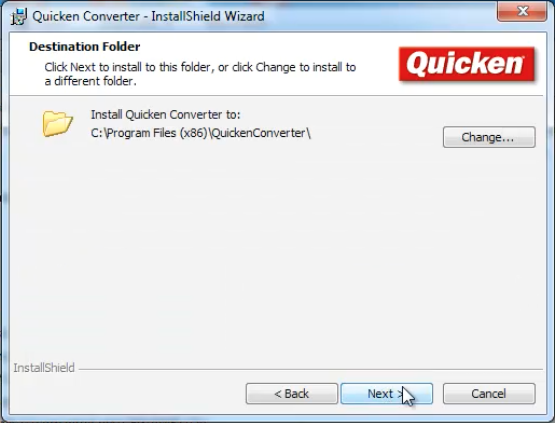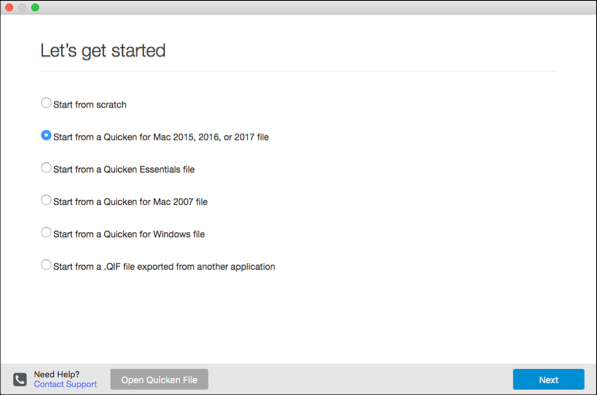- Converting Quicken For Windows To Quicken For Mac 2017 Free
- Converting Quicken For Windows To Quicken For Mac 2017 Book
This tutorial shows how to convert a transaction file to QIF format. We will use Bank2QIF utility.
Step by step instructions for Windows
- Quicken Converter is suitable for 32-bit versions of Windows XP/Vista/7/8/10. This free software was originally developed by Intuit, Inc. The following versions: 24.0, 23.1 and 22.1 are the most frequently downloaded ones by the program users. Billmind.exe or QuickenConverter.exe are the frequent file names to indicate the Quicken Converter.
- Quicken for Mac 2015-2017 Conversion Instructions Express Web Connect Introduction As FirstMerit Bank completes its system conversion to Huntington, you will need to modify your Quicken settings to ensure the smooth transition of your data. Please reference the dates next to each task as this information is time sensitive.
- However, it still lags behind Quicken for Windows in some areas and we're still waiting for equality with the PC version. However, the changes and enhancements to Quicken 2017 for Mac show that the new owners are moving in the right direction. You can get Quicken 2017 for Mac from the Mac App Store for $74.99 or from Amazon for around $43.71.
- The file type for a Quicken Windows data file is.QDF, that is what you would normally be transferring to the Mac and let it upload/convert. In the 'background' the converter will be using a 'part of Quicken Windows' to convert to a file format that has a type.QXF.
Note the Windows program is 32-bit and will not run on your operating system, that is why it has to be run on the server. This just puts the data in a format that Quicken Mac knows how to read and convert into its data file format. Quicken Mac will then use the.QXF file to create your new Quicken Mac data file and delete the.QXF file.
Follow the steps below for the Windows version, followed by the Mac version.
Make sure you are using the latest version of Bank2QIF. Download it from the Bank2QIF download page. Start Bank2QIF and select the transaction file (it could be QBO file, OFX file, QFX file, QIF file, PDF file, MT940 file or STA).
Review transactions before converting, check that dates are correct, have the correct year, deposits and withdrawals are assigned correctly.
Select the QIF target to match your Quicken version or your accounting software.
Set the Account Name and the Account Type to create a QIF file for the right account.
Set the Date format if applicable. Quicken expects date format as MM/DD'YYYY, regardless of your system settings, and other software may expect your system date format.
Click the 'Convert' button to create a QIF file.
Confirm the file name and location.
Import created QIF file into Quicken 2017
Now the QIF file is created, let's switch to Quicken and import created QIF file. Before importing a QIF file make sure to backup your data. To import a QIF file, select 'File' - 'File Import' - 'QIF File', select created QIF file.

For Quicken 2017 or earlier, it is important to select 'All Accounts'. For Quicken 2018 or later you have to select the actual account.
Then click the 'Import' button.
Then click the 'Done' button.
Now your data is imported. You can review transactions and use Renaming Rules if you like. Then click 'Accept All transactions'.
They accepted and listed in Quicken.
Step by step instructions for macOS
Make sure you are using the latest version of Bank2QIF. Download it from the Bank2QIF download page. Start Bank2QIF and select the transaction file (it could be QBO file, OFX file, QFX file, QIF file, PDF file, MT940 file or STA).

Review transactions before converting, check that dates are correct, have the correct year, deposits and withdrawals are assigned correctly.
Select the QIF Target to match your Quicken version or your accounting software: Quicken 2018+, Quicken 2017, Quicken 2015-2016, Quicken 2014 or earlier, Banktivity, Microsoft Money, NetSuite, MYOB, Reckon, YNAB, Quicken 2007 for Mac, Quicken UK, AccountEdge.
Set the Date format if applicable. Quicken expects date format as MM/DD'YYYY, regardless of your system settings, and other software may expect your system date format.
Make sure to set the Account Name and the Account Type to create a QIF file for the right account.
Click the 'Convert' button to create a QIF file.
Confirm the file name and location.
Import created QIF file into Banktivity
Now the QIF file is created, let's switch to Banktivity and import created QIF file. Before importing a QIF file make sure to backup your data. To import a QIF file, select 'File' - 'Import transactions'. Then click 'Import File', select created QIF file.
Select a Quicken account to import.
Then click the 'Continue' button.
Now your data is imported. Review transactions after import.
Related articles
This tutorial shows how to convert a QIF file from your bank or credit card statement to QFX (Web Connect) and import into Quicken. We will use QIF2QFX utility.
Step by step instructions for Windows
Follow the steps below for the Windows version, followed by the Mac version.
Make sure you are using the latest version of QIF2QFX. Download it from the QIF2QFX download page. Start QIF2QFX and select a QIF file.
Review transactions before converting, check that dates are correct, have the correct year, deposits and withdrawals are assigned correctly.
Select the QFX target to match your Quicken version or your accounting software: Regular QFX, Quicken 2018+, Quicken 2017, Quicken 2016, Quicken 2015, YNAB.
Set INTU.BID to match your bank or keep the default value. The INTU.BID value defines the bank label shown during import. It has to be from the allowed bank. You can try to locate your bank. Make sure a bank you choose, supports the Account Type you are converting for. You have to leave it empty if your bank is not listed, so the default Wells Fargo Bank Label (3000) will be used.
Set the Account ID (number) and the Account Type to create QFX for the right account. For multiple accounts, use a different Account ID for each account.
Currency should be USD even for non-USD accounts for Quicken US edition. For the Canadian edition, you can use USD and CAD. And for the UK edition, GBP currency must be set. You can also set End balance, Bank ID, Branch ID if your accounting software requires it.

Click the 'Convert' button to create a QFX file.
Confirm the file name and location.
Import created QFX file into Quicken
Now the QFX file is created, let's switch to Quicken and import created QFX file. Before importing a QFX file backup your data file and make sure that account is not connected to online services. Right-Click - 'Edit/Delete account'.
Then click 'Online Services' and click on the 'Deactivate' button. Then click 'Yes' and 'Ok'.
To import a QFX file, select 'File' - 'File Import' - 'Web Connect (.QFX) File', select created QFX file.
You can select 'Create a new account' or you can select 'Link to an existing account to import transactions'. If you are disconnected from online services, that account will be shown on the list. You may choose to keep online services connected and import into a new account if you have something temporary to import. You can import in that account, and then move transactions from that account to another account. So this way you will keep the existing account connected to online services and you don't have to connect it back later.
Then click the 'Import' button.
Converting Quicken For Windows To Quicken For Mac 2017 Free
Then click the 'Close' button.
Now your data is imported. You can accept all transactions.
Review transactions after QFX import.
Step by step instructions for macOS
Make sure you are using the latest version of QIF2QFX. Download it from the QIF2QFX download page. Start QIF2QFX and select a QIF file.
Review transactions before converting, check that dates are correct, have the correct year, deposits and withdrawals are assigned correctly.
Set the Account ID (number) and the Account Type to create QFX for the right account. For multiple accounts, use a different Account ID for each account.
Currency should be USD even for non-USD accounts for Quicken US edition. For the Canadian edition, you can use USD and CAD. And for the UK edition, GBP currency must be set. You can also set End balance, Bank ID, Branch ID if your accounting software requires it.
Set INTU.BID to match your bank or keep the default value. The INTU.BID value defines the bank label shown during import. It has to be from the allowed bank. You can try to locate your bank. Make sure a bank you choose, supports the Account Type you are converting for. You have to leave it empty if your bank is not listed, so the default Wells Fargo Bank Label (3000) will be used.
Click the 'Convert' button to create a QFX file.
Confirm the file name and location.
Import created QFX file into Quicken
Converting Quicken For Windows To Quicken For Mac 2017 Book
Now the QFX file is created, let's switch to Quicken and import created QFX file. Before importing a QFX file backup your data file and click 'Quicken' - Preferences' and 'Connected Services'.
Make sure to uncheck 'Clean up payees. Automatically improve the quality of downloaded payee names', because when this checkbox set, it could change the payee names to something unrecognizable, not what you have on QFX File.
Before converting into the specific account, make sure that the account is not connected to online services. Right-click - 'Edit' account.
If you see, for example, Connection Type (Web Connect), it means that it is connected. We have to disconnect from online services first. Click on 'Set up transaction download'.
Then click the 'Options' button.
Select 'Manual' and click the 'Continue' button.
Click the 'Finish' button. This way you disconnect from direct online download and now you can import a QFX file into this account.
To import a QFX file, select 'File' - 'Import' - 'Bank or Brokerage File (OFX, QFX)', select created QFX file.
And select an existing account to import transactions instead 'Add a new Quicken account'. Click the 'Continue' button.
Now your transactions are imported. You can categorize, review, delete them. They are already inside Quicken.